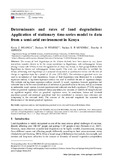Determinants and rates of land degradation: Application of stationary time-series model to data from a semi-arid environment in Kenya

View/
Date
2018-02Author
Mganga, K. Z.
Nyariki, Dickson M.
Musimba, N. K. R.
Amwata, Dorothy A.
Metadata
Show full item recordAbstract
The causes of land degradation in the African drylands have been shown to vary. Some researchers consider climate to be the major contributor to degradation, with anthropogenic factors playing a minor role. Others reverse the significance of these two factors. A third group attributes land degradation to climate and anthropogenic factors equally. This study was undertaken to establish the factors influencing land degradation in a semi-arid environment in southeastern Kenya and the rate of change in vegetation types for a period of 35 years (1973–2007). The reduction in grassland cover was used as an indicator of land degradation. Causes of land degradation were determined by a multiple regression analysis. A log-linear regression analysis was used to establish the rate of vegetation change. The multiple and log-linear regression analyses showed: (1) woody vegetation, livestock population and cultivated area to be the main contributors of reduction in grassland cover in the area, and (2) an increase in undesirable woody species, livestock population and cultivated area had a significant (P<0.05) negative effect on grassland vegetation. Increased human population, low amounts of rainfall and drought showed no significant negative effect on grassland vegetation cover. In conclusion, human and livestock population growth and increased agricultural land have contributed to intensive crop cultivation and overgrazing in the semi-arid lands. This overuse of the semi-arid rangelands has worsened the deterioration of the natural grassland vegetation.
URI
https://link.springer.com/article/10.1007/s40333-017-0036-0http://hdl.handle.net/123456789/2954
https://pubag.nal.usda.gov/catalog/5890404
https://www.researchgate.net/publication/322275165_Determinants_and_rates_of_land_degradation_Application_of_stationary_time-series_model_to_data_from_a_semi-arid_environment_in_Kenya
https://researchportal.helsinki.fi/en/publications/determinants-and-rates-of-land-degradation-application-of-station-2
http://repository.seku.ac.ke/handle/123456789/3802
Collections
- Journal Articles (BE) [396]
